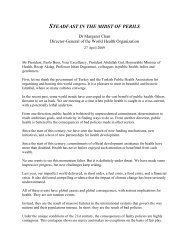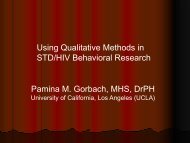The Evolution of HTA in Emerging Markets Health-Care ... - TREE
The Evolution of HTA in Emerging Markets Health-Care ... - TREE
The Evolution of HTA in Emerging Markets Health-Care ... - TREE
You also want an ePaper? Increase the reach of your titles
YUMPU automatically turns print PDFs into web optimized ePapers that Google loves.
OHE Consult<strong>in</strong>g Report for PhRMA<br />
5 January 2011<br />
expectations <strong>of</strong> access. <strong>The</strong> situation <strong>in</strong> Brazil exemplifies this, as once products are approved<br />
for market<strong>in</strong>g authorisation and for <strong>in</strong>novative products, an <strong>in</strong>itial price is set via external<br />
reference pric<strong>in</strong>g rules (and adjusted subsequently by SUS/CMED for <strong>in</strong>flation, affordability,<br />
etc.), then citizens can sue for access even though the public system has not yet approved the<br />
product for use <strong>in</strong> the public plan.<br />
<br />
In Taiwan, the role <strong>of</strong> <strong>HTA</strong> appears to be exclusively <strong>in</strong> the area <strong>of</strong> drug reimbursement, and here<br />
it is unclear how it fits logically alongside an <strong>in</strong>ternational reference price system. In theory,<br />
drugs show<strong>in</strong>g <strong>in</strong>cremental value can get higher prices with<strong>in</strong> the range <strong>of</strong> reference price<br />
comparisons. <strong>The</strong>re are also some issues around process such as the degree <strong>of</strong> transparency <strong>of</strong><br />
the assessment and the relationship between the assessment and the drug licens<strong>in</strong>g process.<br />
Our understand<strong>in</strong>g is that expertise for the conduct <strong>of</strong> pharmacoeconomic assessments is drawn<br />
from the licens<strong>in</strong>g body but used separately. However, this arrangement clearly causes concern<br />
for the <strong>in</strong>dustry that assessments <strong>of</strong> safety and efficacy may be conflated <strong>in</strong> some way with<br />
assessments <strong>of</strong> relative effectiveness and cost-‐effectiveness.<br />
Issues for PhRMA <strong>in</strong> develop<strong>in</strong>g public policy positions<br />
<strong>The</strong> PhRMA, EFPIA, and IFPMA pr<strong>in</strong>ciples for good practice <strong>in</strong> <strong>HTA</strong> and Evidence-‐based Medic<strong>in</strong>e<br />
provide a consistent approach to “micro <strong>HTA</strong>” and cont<strong>in</strong>ue to provide a solid framework for<br />
approach<strong>in</strong>g <strong>HTA</strong> issues globally. <strong>The</strong>y are <strong>in</strong>tended to be applied <strong>in</strong> a reactive way – <strong>in</strong> the event <strong>of</strong><br />
a payer and/or government propos<strong>in</strong>g the use <strong>of</strong> “micro <strong>HTA</strong>”.<br />
We have sought to develop a framework for putt<strong>in</strong>g such a position <strong>in</strong>to the context <strong>of</strong> health care<br />
system development and <strong>HTA</strong> evolution. Our key po<strong>in</strong>ts are that <strong>HTA</strong> is resource <strong>in</strong>tensive and that<br />
an appropriate <strong>in</strong>itial focus for skilled people may well be on “macro <strong>HTA</strong>” or other health system<br />
issues rather than “micro <strong>HTA</strong>”.<br />
This gives rise to several issues:<br />
<br />
<br />
<br />
As compliance with good <strong>HTA</strong> pr<strong>in</strong>ciples is resource-‐<strong>in</strong>tensive for governments (and for<br />
<strong>in</strong>dustry), countries may seek to “free ride” on the systems <strong>of</strong> other countries to avoid us<strong>in</strong>g<br />
scarce skills and resources. Indeed, as we have noted earlier, the global public good nature <strong>of</strong><br />
much evidence means that “not re<strong>in</strong>vent<strong>in</strong>g the wheel” can make sense and be efficient.<br />
However, use <strong>of</strong> alternative “low resource” options may be less efficient than an efficient use <strong>of</strong><br />
<strong>HTA</strong>. For example, the use <strong>of</strong> <strong>in</strong>ternational reference pric<strong>in</strong>g to countries at a similar stage <strong>of</strong><br />
<strong>in</strong>come-‐per-‐capita and with similar health care systems can make sense if the referenced<br />
countries have used appropriate methods to derive their prices. However, <strong>in</strong>ternational<br />
reference pric<strong>in</strong>g <strong>in</strong> practice can lead <strong>in</strong>dividual country markets to seek lower-‐than-‐optimal<br />
price levels not consistent with long-‐term, global dynamic efficiency (Danzon et al, 2010). <strong>HTA</strong><br />
may therefore be preferable to <strong>in</strong>ternational reference pric<strong>in</strong>g if it is used to assess value <strong>in</strong> a<br />
way that reflects local will<strong>in</strong>gness to pay for health ga<strong>in</strong>;<br />
<strong>The</strong> use <strong>of</strong> therapeutic reference pric<strong>in</strong>g requires less <strong>in</strong>put than <strong>HTA</strong> but can discourage<br />
<strong>in</strong>novation and reduce the likelihood <strong>of</strong> efficient use <strong>of</strong> the product (Drummond et al, 2010). It<br />
15








